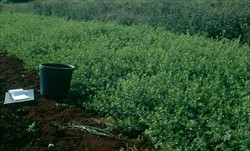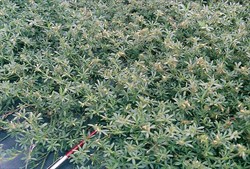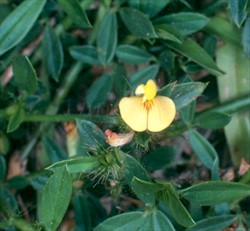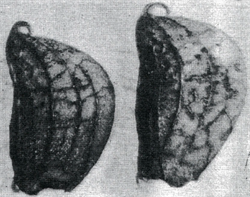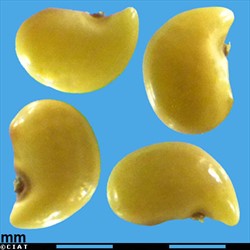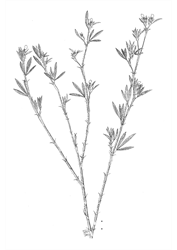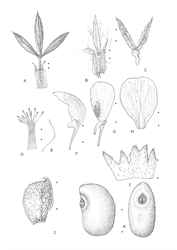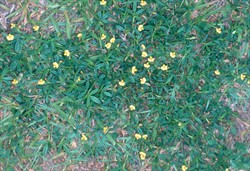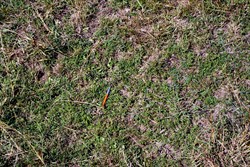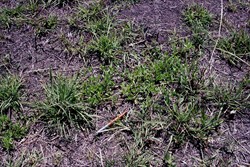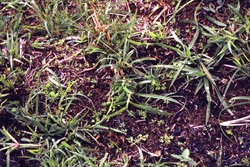Stylosanthes guianensis var. intermedia
Tropical Forages
Stylosanthes guianensis (Aubl.) Sw. var. intermedia (Vogel) Hassl.
Conspecific taxa:
Stylosanthes guianensis (Aubl.) Sw.
Stylosanthes guianensis (Aubl.) Sw. var. dissitiflora (B.L. Rob. & Seaton) ʼt Mannetje
Stylosanthes guianensis (Aubl.) Sw. var. guianensis
Stylosanthes guianensis (Aubl.) Sw. var. longiseta (Micheli) Hassl.
Stylosanthes guianensis (Aubl.) Sw. var. marginata Hassl.
Stylosanthes guianensis (Aubl.) Sw. var. robusta ʼt Mannetje
Basionym: Stylosanthes montevidensis Vogel var. intermedia Vogel; Stylosanthes campestris M.B. Ferreira & Sousa Costa; Stylosanthes hippocampoides Mohlenbr.
Family: Fabaceae (alt. Leguminosae) subfamily: Faboideae tribe: Dalbergieae subtribe: Stylosanthinae.
A prostrate to ascendant (rarely erect), much branched perennial to 30 cm, with stems mostly 1‒2 mm diameter, covered with sparse radiating bristles about 1.5 mm long; well-developed crown with buds both below and above ground level, nodal rooting rare, strong taproot. Leaves trifoliolate, leaflets bright to deep green, 15‒35 mm long, 3‒5 mm wide, few hairs. Flowers yellow, borne in compact spikes, with 4‒20 flowers/spike. Pods light brown, flattened, single-seeded, 3 mm long and 2 mm wide with a minute coiled beak; conspicuously reticulately fine-veined without hairs. Pods shed as they ripen. Seeds yellowish brown. About 380,000 seeds-in-pod and 770,000 dehulled seeds per kg.
English: fine stem stylo
Native:
South America: Argentina (Córdoba, Corrientes, Misiones); Bolivia (e.); Brazil (Bahia, Goiás, Mato Grosso, Mato Grosso do Sul, Paraná, Rio de Janeiro, Santa Catarina, São Paulo); Paraguay; Uruguay
Cultivated:
Africa: South Africa; Zimbabwe
Australasia: Australia (New South Wales (n.e.), Queensland (s.e.))
Forage
Mainly used as a source of leguminous protein in sub-humid, subtropical native pastures dominated by early-maturing grasses such as Heteropogon contortus and Hyparrhenia spp.
Soil requirements
Occurs naturally on sands to light clays of pH 6.5‒7.0, rarely 5.5. Adapted to well-drained, friable-surfaced, low to moderate fertility, sandy to well-structured clay soils in subtropical environments. Best on sands and sandy loams. Not adapted to heavy clays, and generally poor on surface-sealed soils. Grows best in soils of near neutral pH, although has grown well on sandy soils of pH 5.0. Responds to application of phosphorus in infertile soils. No record of salinity tolerance.
Moisture
Occurs in areas with annual rainfall from 600 to 1,800 mm. Mostly sown in areas with rainfall of 700‒900 mm. Very drought tolerant, but very intolerant of flooding and waterlogging. Suggested that presence of sedges (Cyperaceae) may indicate unsuitability for S. guianensis var. intermedia.
Temperature
Mostly found between18 and 33° S (with possible outliers at 12º45' S in Bahia, Brazil and 36º S in Buenos Aires Province, Argentina). This largely equates to an average annual temperature range of about 16‒24 ºC. In cultivation, S. guianensis var. intermedia has proven successful between latitudes 23‒29º near sea level, and 17‒19º at >1,200 m asl. Commences growth early in the growing season and in the absence of frosts, continues to grow into the cool season. Optimum temperature for growth is approximately 27‒29 °C. Tops remain unaffected by light frosts, but are killed by heavy frost. Crowns of established plants survive temperatures of -10 °C.
Light
Requires full sun or very open shade. Not well-suited to agroforestry.
Reproductive development
A long day plant, S. guianensis var. intermedia flowers and sets seed through much of the growing season, with a peak towards the middle of the warm season.
Defoliation
Benefits from regular defoliation, and dies out in association with taller grasses if fairly intensive management not maintained. Crowns develop a profusion of short leafy shoots in a prostrate rosette under heavy grazing, giving the plant a higher leaf to stem ratio. Can be grazed throughout the year.
Fire
Survives fire well because of its buried crown. There is usually dense seedling development following fire due to heat-softening of hard seed and reduced competition.
Guidelines for establishment and management of sown forages.
Establishment
High levels of hard seed in the absence of scarification. Can break dormancy by: (a) mechanical scarification; (b) immersion in water at 80 °C for 10‒15 minutes, and cooling for 40 minutes; (c) treating with concentrated sulphuric acid for 10 minutes, wash and dry; (d) pass seed over hot surface at 120 ºC for 15 seconds. It is fairly specific in its rhizobial requirements, and seed should be inoculated with CB 82, CB 1650, CB 1552, or similar strains prior to planting in areas not growing other Stylosanthes spp. Seed can be broadcast after light cultivation or drilled at 2‒5 kg/ha, sowing no deeper than 1‒1.5 cm. Seed can also be broadcast onto ash following fire, providing the area is continuously stocked after seeding to reduce grass competition. Generally slow to establish.
Fertilizer
Efficient in extracting phosphorus from the soil and grows quite well without fertilizer, but may require 20 kg/ha P in P deficient soils.
Compatibility (with other species)
In its adapted low rainfall environment, it competes successfully with weeds. Combines well with grasses in more open stands.
Companion species
Grasses: Bothriochloa pertusa, Digitaria eriantha, Heteropogon contortus.
Legumes: Aeschynomene falcata, Chamaecrista rotundifolia, Listia bainesii, Stylosanthes scabra.
Pests and diseases
Although infected by anthracnose caused by Colletotrichum gloeosporioides late in the season, the disease is of little consequence. Legume little-leaf disease caused by phytoplasma can reduce production in some seasons and head blight caused by Botrytis cinerea can be a problem in seed crops under humid conditions. Seed-harvesting ants can affect establishment of new stands and reduce the opportunity to build soil seed reserves.
Ability to spread
High levels of seed production. Spread through ingestion by livestock and through surface water movement. Has become naturalized at significant distances from sown area.
Weed potential
No record of weediness.
Nutritive value
CP levels in DM at mid-full bloom stage average 16%, and P levels 0.23%, while end of season values have been measured at 9% and 0.15%, respectively.
Palatability/acceptability
It is well grazed, the proportion in the diet increasing through the season as the associated grass becomes more fibrous.
Toxicity
No problems recorded.
Feedipedia link
Dry matter
Generally low production, with yields of the order of 2‒5 t/ha DM growing in association with grass producing about 2 t/ha DM. Yields can be doubled with the use of phosphatic fertilizer.
Animal production
Can improve animal performance by 30‒80 kg/hd/yr over those on declining quality grass pastures, at a stocking rate of c. 1 beast/2.5 ha. May also increase the carrying capacity of the pasture, although such a step should be approached with caution. The legume can often tolerate higher grazing pressure than the associated grass. Relatively low amounts can have a significant effect on animal production.
Self-pollinated; chromosome number 2n = 20. The original fine stem stylo released in Australia was a mixture of 2 accessions, giving a variety with asynchronous flowering, which led to difficulties in assessing seed harvest time. Cv. Oxley resulted from selection within the mixture to obtain a more synchronized seed crop.
Ripe seed is readily dislodged from the flower head, making mechanical harvesting difficult. Commercial seed is usually produced under irrigation, and harvested with a combine harvester, usually in February/March in the southern hemisphere. This may be followed by suction harvesting to recover fallen seed, which can double the total yield. Where labour is plentiful and cheap, hand harvesting of seed can provide a valuable source of income to smallholder farmers. Seed yields range from 300 to 500 kg/ha, but up to 1,000 kg/ ha has been obtained by manual sweeping and winnowing of fallen seed.
Tolerant of 2,4-D, 2,4-DB, acifluorfen, bentazone, and fluazifop-butyl, but moderately susceptible to sethoxydim.
- Buried crown protects plant from fire, frost and heavy grazing.
- More cold tolerant than most warm season legumes.
- Responds well to heavy grazing pressure.
- Largely resistant to anthracnose.
- Efficient in extracting calcium and phosphorus from the soil.
- Naturalizes on suitable country.
- Intolerant of even marginally impeded drainage.
- Difficulty of seed harvest.
- Specific rhizobium.
- Low dry matter yields.
Bowen, E.J. and Rickert, K.G. (1979) Beef production from native pastures sown to fine-stem stylo in the Burnett region of south-eastern Queensland. Australian Journal of Experimental Agriculture and Animal Husbandry 19:140–149. https://doi.org/10.1071/EA9790140
Cameron, D.G. (1987) Tropical and subtropical pasture legumes. 14. Fine stem stylo (Stylosanthes guianensis var. intermedia): The subtropical stylo. Queensland Agricultural Journal 113:83–87.
Clatworthy, J.N. and Holland, D.G.E. (1979) Effects of legume reinforcement of veld on the performance of beef steers. Proceedings of the Grassland Society of Southern Africa 14:111–114. doi.org/10.1080/00725560.1979.9648871
Jingura, R.M., Sibanda, S. and Hamudikuwanda, H. (2001) Yield and nutritive value of tropical forage legumes grown in semi-arid parts of Zimbabwe. Tropical Grasslands 35:168–174. goo.gl/Ee4Ez2
Mannetje, L.’t (1977) A revision of varieties of Stylosanthes guianensis (Aubl.) Sw. Australian Journal of Botany 25:347–362. doi.org/10.1071/BT9770347'Oxley' (composite of CPI 11491 and CPI 11493) Released in Australia (1969). Origin Mercedes (Corrientes), Argentina (29º S, 80 m asl, rainfall 1,200 mm) and Asunción, Paraguay (25º S, 90 m asl, rainfall 1,350 mm), respectively. Uniform line selected from the variable composite based on morphology and flowering time. Although largely evaluated on sandy soils in the subtropics, it has proven useful in other well-drained soils, primarily for sowing into native pasture .
None reported.
